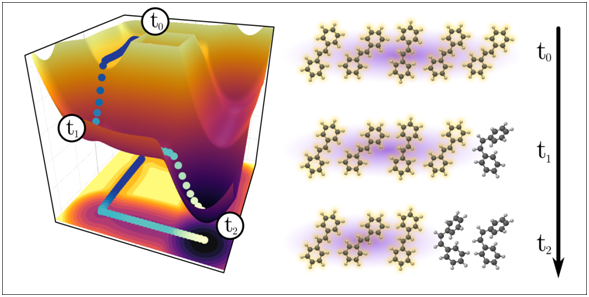Polaritonic chemistry: One photon to rule them all
Most plant and animal life on Earth depends on photosynthesis, a process in which green plants synthesize carbohydrates from CO2 and water, the reverse of this reaction provides energy for plants and animals. But the equilibrium of the reaction favours the reactants, not the products. It is the presence of UV light and of the green pigment chlorophyll what makes the photosynthesis, and life as we know it, possible.
The absorption of a photon of light may raise a molecule to an excited electronic state, where it will be more likely to react than in the ground electronic state. In the so-called photochemical reactions, as the one at the heart of photosynthesis, the activation energy is supplied by the absorption of ultraviolet or visible light. In contrast, the usual chemical reactions are thermal reactions, in which the activation energy is supplied by intermolecular collisions.
Usually the number of photons absorbed equals the number of molecules making a transition to an excited electronic state. This is the Stark–Einstein law of photochemistry. But, in exceptional circumstances, this law is violated. For example, a high-power laser beam provides a very high density of photons. Thus, there is a non-zero probability that a molecule will be hit almost simultaneously by two laser-beam photons, producing a transition in which a single molecule absorbs two photons at once.
Also it may be the case that a single photon can excite two molecules in contact with each other. This explains why liquid O2 is light blue, because of the absorption of 630-nm (red) light; each photon absorbed excites two colliding O2 molecules to the lowest-lying O2 excited electronic state.

But, what if there were a way to circumvent consistently the Stark-Einstein law? This is exactly what researchers from ICIMAC and DIPC have just found 1, possibly unlocking a complete new class of collective reactions. They use a kind of exotic collective excitations called polaritons.
Polaritons are the result of a strong coupling of electromagnetic waves with an electric or magnetic dipole-carrying excitation, and, if we consider them quasiparticles, these represent somehow an hybrid state between light and matter.
The feasibility of polaritonic chemistry, to wit, the potential to manipulate chemical structure and reactions through the formation of polaritons was experimentally demonstrated in 2012. The new approach exploits the collective nature of polaritons formed by bringing a collection of molecules into strong coupling with a confined light mode. This can allow many molecules to undergo a photochemical reaction after excitation by just a single photon.
The mechanism relies on the delocalized character of polaritons, what we can imagine as the formation of a single “supermolecule” involving all the molecules as well as the trapped photon. The photochemical reaction induced in this supermolecule can then lead to most or even all of its molecular constituents undergoing a structural change, breaking the Stark-Einstein law but not, as could be expected, energy conservation.
The researchers study a specific model for a class of reactions that release energy, in other words, where the initial starting state after absorption of a photon has higher energy than the final state, in which all involved molecules have undergone a reaction. In particular they focus on a class of model molecules with a structure proposed for use in solar energy storage.
They found that the new approach could resolve one of the main problems of solar energy storage; namely, how to efficiently retrieve the stored energy from molecules that are designed for the opposite purpose, i.e., for storing energy very efficiently under normal conditions. By reversibly bringing the system into strong coupling (e.g., through a moving mirror that brings the cavity into and out of resonance), one could thus trigger the release of the stored energy through absorption of a single ambient photon.
Author: César Tomé López is a science writer and the editor of Mapping Ignorance.
References
- Javier Galego, Francisco J. Garcia-Vidal, and Johannes Feist (2017) Many-Molecule Reaction Triggered by a Single Photon in Polaritonic Chemistry Physical Review Letters 119, 136001 doi: 10.1103/PhysRevLett.119.136001. ↩